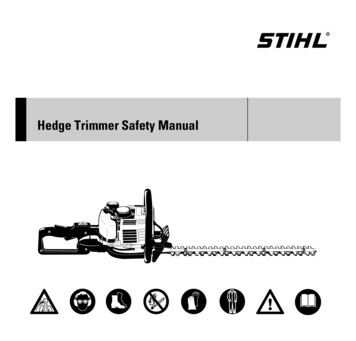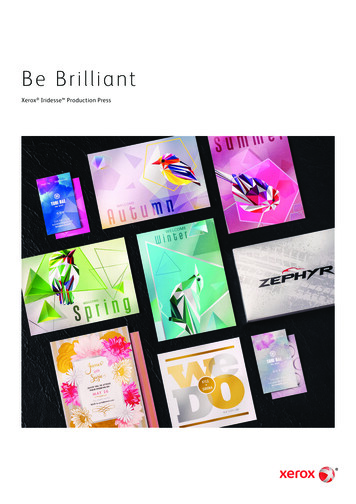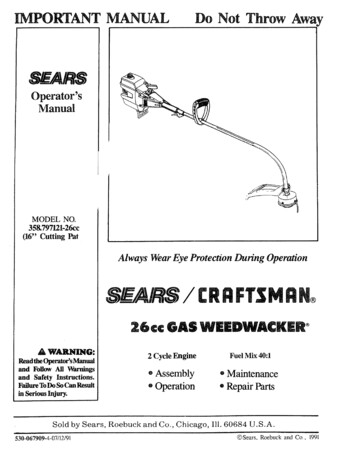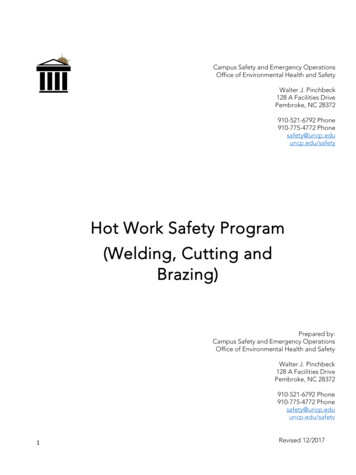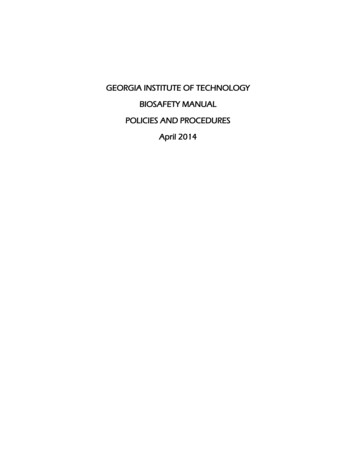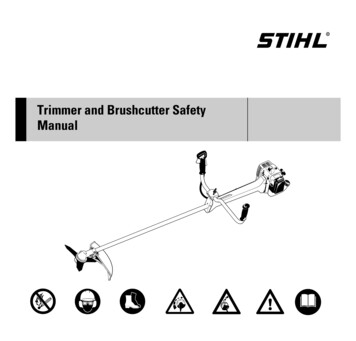
Transcription
{Trimmer and Brushcutter SafetyManual
EnglishSafety Precautions and WorkingTechniquesMaintenance and CareMain Parts21214 ANDREAS STIHL AG & Co. KG, 20120457-187-0121. VA0.E12.0000000742 003 GBThis manual contains the safetyprecautions and recommended workingtechniques outlined in the instructionmanuals for STIHL trimmers andbrushcutters.The chapter on "Main Parts andControls" shows the FS 130 as anexample. Other trimmers andbrushcutters may have different partsand controls.This manual contains references tovarious chapters in the model-specificinstruction manuals.Printed on chlorine-free paperPrinting inks contain vegetable oils, paper can be recycled.Original Instruction ManualContentsYou should therefore always refer to theinstruction manual of your particulartrimmer or brushcutter model.The approved combinations of cuttingattachment, deflector, handle andharness are particularly important. Useonly the combinations approved in themodel-specific instruction manual.Please contact your STIHL dealer if youhave any questions after reading thismanual.{Trimmer and Brushcutter Safety ManualThis instruction manual is protected by copyright. All rights reserved, especially the rights to reproduce, translate and processwith electronic systems.1
EnglishSafety Precautions andWorking TechniquesSome special safety precautions must beobserved to reduce therisk of personal injurywhen operating thispower tool because of thevery high speed of its cutting attachment.It is important you readand understand theinstruction manual beforefirst use and keep themanual in a safe place forfuture reference. Nonobservance of theinstruction manual mayresult in serious or evenfatal injury.Observe all application local safetyregulations, standards and ordinances.If you have not used this type of powertool before: Have your dealer or otherexperienced user show you how tooperate your power tool or attend aspecial course in its operation.Do not lend or rent your power toolwithout the instruction manual. Be surethat anyone using it understands theinformation contained in this manual.servicing dealer. Use only high qualityparts and accessories in order to avoidthe risk of accidents and damage to themachine.The use of noise emitting power toolsmay be restricted to certain times bynational or local regulations.STIHL recommends the use of originalSTIHL replacement parts. They arespecifically designed to match yourmodel and meet your performancerequirements.To operate the power tool you must berested, in good physical condition andmental health.If you have any condition that might beaggravated by strenuous work, checkwith your doctor before operating apower tool.Persons with pacemakers only: Theignition system of your power toolproduces an electromagnetic field of avery low intensity. This field mayinterfere with some pacemakers. STIHLrecommends that persons withpacemakers consult their physician andthe pacemaker manufacturer to reduceany health risk.Do not operate the power tool if you areunder the influence of any substance(drugs, alcohol) which might impairvision, dexterity or judgment.Keep bystanders, especially children,and animals away from the work area.Depending on the cutting attachmentfitted, use your power tool only forcutting grass, wild growth, shrubs,scrub, bushes, small diameter trees andsimilar materials.When the power tool is not in use, shut itoff so that it does not endanger others.Secure it against unauthorized use.Do not use your power tool for any otherpurpose because of the increased risk ofaccidents.The user is responsible for avoidinginjury to third parties or damage to theirproperty.Only use cutting attachments andaccessories that are explicity approvedfor this power tool model by STIHL orare technically identical. If you have anyquestions in this respect, consult aMinors should never be allowed to use apower tool.2Never attempt to modify your unit in anyway since this may increase the risk ofpersonal injury. STIHL excludes allliability for personal injury and damageto property caused while usingunauthorized attachments.Do not use a pressure washer to cleanthe power tool. The solid jet of watermay damage parts of the power tool.The deflector on this power tool cannotprotect the operator from all objectsthrown by the cutting attachment(stones, glass, wire, etc.). Such objectsmay ricochet and then hit the operator.Clothing and EquipmentWear proper protective clothing andequipment.Clothing must be sturdybut allow complete freedom of movement. Wearsnug-fitting clothing, anoverall and jacket combination, do not wear awork coat.Trimmer and Brushcutter Safety Manual
EnglishAvoid clothing that couldget caught on branchesor brush or moving partsof the machine. Do notwear a scarf, necktie orjewelry. Tie up and confine long hair (e.g. with ahair net, cap, hard hat,etc.).Do not fuel a hot engine – fuel may spilland cause a fire.Transporting the Power ToolOpen the fuel cap carefully to allow anypressure build-up in the tank to releaseslowly and avoid fuel spillage.Fuel your power tool only in wellventilated areas. If you spill fuel, wipethe machine immediately – if fuel gets onyour clothing, change immediately.Wear steel-toed safetyboots with non-slip soles.Your power tool comes standard witheither a screw-type or bayonet-type fuelcap.Wear a safety hard hatfor thinning operations,when working in highscrub and where there isa danger of head injuriesfrom falling objects. Toreduce the risk of injuryfrom thrown objects,always wear a face shieldand safety glasses.A face shield alone does not provideadequate eye protection.Wear hearing protection, e.g. earplugsor ear muffs.Wear heavy-duty gloves.STIHL offers a comprehensive range ofpersonal protective clothing andequipment.Trimmer and Brushcutter Safety Manual002BA079 KNSturdy shoes with non-slip soles may beworn as an alternative only when usingmowing heads.Always turn off the engine.Carry the unit hanging from the shoulderstrap or properly balanced by the drivetube. Fit transport guard on metal cuttingattachments to avoid the risk of injuryfrom blade contactTransporting in a vehicle: Properlysecure your power tool to preventturnover, fuel spillage and damage.FuelingAfter fueling, tightendown the screw-type fuelcap as securely aspossible.Insert the fuel cap withhinged grip (bayonet-typecap) correctly in theopening, turn it clockwiseas far as stop and fold thegrip down.This reduces the risk of unit vibrationscausing the fuel cap to loosen or comeoff and spill quantities of fuel.To reduce the risk of serious or fatalburn injuries, check for fuel leakage. Iffuel leakage is found, do not start or runthe engine until leak is fixed.Gasoline is an extremelyflammable fuel. Keepclear of naked flames. Donot spill any fuel – do notsmoke.Always shut off the engine beforerefueling.3
EnglishCheck that your power tool is properlyassembled and in good condition – referto appropriate chapters in the instructionmanual.–Use only an approved combinationof cutting attachment, deflector,handle and harness. All parts mustbe assembled properly andsecurely.–Slide control / stop switch mustmove easily to STOP or 0–Smooth action of throttle triggerinterlock (if fitted) and throttle trigger– the throttle trigger must returnautomatically to the idle position.–Check that the spark plug boot issecure – a loose boot may causearcing that could ignite combustiblefumes and cause a fire.–––4Cutting tool or attachment: Checkfor correct and secure assemblyand good condition.Check protective devices (e.g.deflector for cutting attachment,rider plate) for damage or wear.Always replace damaged parts. Donot operate your machine with adamaged deflector or worn riderplate (lettering and arrows no longerlegible).Never attempt to modify the controlsor safety devices in any way.–Keep the handles dry and clean –free from oil and dirt – for safecontrol of the power tool.–Adjust the harness and handle(s) tosuit your height and reach. Seechapters on "Fitting the Harness"and "Balancing theTrimmer/Brushcutter".To reduce the risk of personal injury, donot operate your power tool if it isdamaged or not properly assembled.If you use a shoulder strap or fullharness: Practice removing and puttingdown the machine as you would in anemergency. To avoid damage, do notthrow the machine to the ground whenpracticing.Starting the engineStart the engine at least 3 meters fromthe fueling spot, outdoors only.Place the unit on firm ground in an openarea. Make sure you have good balanceand secure footing. Hold the unitsecurely. The cutting attachment mustbe clear of the ground and all otherobstructions because it may begin to runwhen the engine starts.Your power tool is a one-person unit. Toreduce the risk of injury from thrownobjects, do not allow other personswithin a radius of 15 meters of your ownposition – even when starting.To reduce the risk ofinjury, avoid contact withthe cutting attachment.Do not drop start thepower tool – start theengine as described inthe instruction manual.Note that the cuttingattachment continues torun for a short periodafter you let go of thethrottle trigger – flywheeleffect.Check idle speed setting: The cuttingattachment must not rotate when theengine is idling with the throttle triggerreleased.To reduce the risk of fire, keep hotexhaust gases and hot muffler awayfrom easily combustible materials (e.g.wood chips, bark, dry grass, fuel).Holding and Controlling the Power ToolAlways hold the power tool firmly withboth hands on the handles.Make sure you always have goodbalance and secure footing.Models with bike handle002BA055 KNBefore StartingRight handle on control handle, left handon left handle.Trimmer and Brushcutter Safety Manual
EnglishCheck and correct the idle speed settingat regular intervals. If the cuttingattachment still rotates at idle speed,have your dealer make properadjustments or repairs. STIHLrecommends a STIHL servicing dealer.002BA080 KNModels with loop handleOn models with a loop handle andbarrier bar, left hand on loop handle,right hand on control handle, even if youare left-handed.During OperationMake sure you always have goodbalance and secure footing.In the event of impending danger or inan emergency, switch off the engineimmediately by moving the slide control/ stop switch to STOP or 0.15m (50ft)To reduce the risk of injury, do not allowany other persons within a radius of 5meters of your own position. To reducethe risk of damage to property, alsomaintain this distance from other objects(vehicles, windows).The correct engine idle speed isimportant to ensure that the cuttingattachment stops rotating when you letgo of the throttle trigger.Trimmer and Brushcutter Safety ManualTake special care in slippery conditions– damp, snow, ice, on slopes or unevenground.Watch out for obstacles: Roots, treestumps or holes which could cause youto trip or stumble.Always stand on the ground whileworking, never on a ladder, workplatform or any other insecure support.Be particularly alert and cautious whenwearing hearing protection becauseyour ability to hear warnings (shouts,alarms, etc.) is restricted.To reduce the risk of accidents, take abreak in good time to avoid tiredness orexhaustion.Work calmly and carefully – in daylightconditions and only when visibility isgood. Stay alert so as not to endangerothers.Your power tool producestoxic exhaust fumes assoon as the engine isrunning. These fumesmay be colorless andodorless and containunburned hydrocarbonsand benzol. Never runthe engine indoors or inpoorly ventilated locations, even if your modelis equipped with a catalytic converter.To reduce the risk of serious or fatalinjury from breathing toxic fumes,ensure proper ventilation when workingin trenches, hollows or other confinedlocations.To reduce the risk of accidents, stopwork immediately in the event ofnausea, headache, visual disturbances(e.g. reduced field of vision), problemswith hearing, dizziness, deterioration inability to concentrate. Apart from otherpossibilities, these symptoms may becaused by an excessively highconcentration of exhaust gases in thework area.Operate your power tool so that itproduces a minimum of noise andemissions – do not run the engineunnecessarily, accelerate the engineonly when working.To reduce the risk of fire, do not smokewhile operating or standing near yourpower tool. Note that combustible fuelvapor may escape from the fuel system.The dusts, vapor and smoke producedduring operation may be dangerous tohealth. If the work area is very dusty orsmoky, wear a respirator.If your power tool is subjected tounusually high loads for which it was notdesigned (e.g. heavy impact or a fall),always check that it is in good conditionbefore continuing work – see also"Before Starting".Check the fuel system in particular forleaks and make sure the safety devicesare working properly. Do not continueoperating your power tool if it isdamaged. In case of doubt, have the unitchecked by your servicing dealer.5
EnglishDo not operate your power tool in thestarting throttle position – engine speedcannot be controlled in this position.To reduce the riskof injuryfromthrown objects,never operate theunit without theproper deflector forthe type of cuttingattachment beingused.Inspect the work area:Stones, pieces of metalor other solid objects canbe thrown and cause personal injury or damagethe cutting attachmentand property (e.g. parkedvehicles, windows).Special care must be taken whenworking in difficult, over-grown terrain.When cutting high scrub, under bushesand hedges: Keep cutting attachment atminimum height of 15 cm to avoidharming small animals.Always shut off the engine beforeleaving the unit unattended.Check the cutting attachment at regularshort intervals during operation orimmediately if there is a noticeablechange in cutting behavior:–Turn off the engine. Hold the unitfirmly and wait for the cuttingattachment to come to a standstill.–Check condition and tightness, lookfor cracks.6–Check sharpness.–Replace damaged or dull cuttingattachments immediately, even ifthey have only superficial cracks.Clean grass and plant residue off thecutting attachment mounting at regularintervals – remove any build up ofmaterial from the cutting attachment anddeflector.To reduce the risk of injury, shut off theengine before replacing the cuttingattachment.Do not continue using or attempt torepair damaged or cracked cuttingattachments by welding, straightening ormodifying the shape (out of balance).This may cause parts of the cuttingattachment to come off and hit theoperator or bystanders at high speedand result in serious or fatal injuries.When using mowing headsEquip the deflector with the additionalcomponents specified in the instructionmanual.Use only the deflector with properlymounted line limiting blade to ensure themowing lines are automatically trimmedto the approved length.To reduce the risk of injury, always turnoff the engine before adjusting the nylonline of manually adjustable mowingheadsUsing the unit with over-long nyloncutting lines reduces the motor'soperating speed. The clutch then slipscontinuously and this causesoverheating and damage to importantcomponents (e.g. clutch, polymerhousing components) – and this canincrease the risk of injury from thecutting attachment rotating while theengine is idling.When using metal cutting attachmentsSTIHL recommends the use of originalSTIHL metal cutting attachments. Theyare specifically designed to match yourmodel and meet your performancerequirements.Metal cutting attachments rotate at veryhigh speed. The forces that occur act onthe machine, the attachment and thematerial being cut.Sharpen metal cutting attachmentsregularly as specified.Unevenly sharpened metal cuttingattachments cause out-of-balancewhich can impose extremely high loadson the machine and increase the risk ofbreakage.Dull or improperly sharpened cuttingedges can put a higher load on thecutting attachment and increase the riskof injuryfrom cracked or broken parts.Inspect metal cutting attachments forcracks or warping after every contactwith hard objects (e.g. stones, rocks,pieces of metal). To reduce the risk ofinjury, remove burrs and other visiblebuild-ups of material (use a file) becausethey may become detached and bethrown at high speed during operation.To reduce the above-mentioned riskswhen using a metal cutting attachment,never use a metal cutting attachmentwith a diameter larger than specified. Itmust not be too heavy. It must beTrimmer and Brushcutter Safety Manual
Englishmanufactured from materials ofadequate quality and its geometry mustbe correct (shape, thickness).To reduce the risk of injury, a metalcutting attachment not manufactured bySTIHL must not be heavier, thicker,have a different shape or a diameterlarger than the largest metal cuttingattachment approved by STIHL for thispower tool model.VibrationsProlonged use of the power tool mayresult in vibration-induced circulationproblems in the hands (whitefingerdisease).No general recommendation can begiven for the length of usage because itdepends on several factors.The period of usage is prolonged by:–Hand protection (wearing warmgloves)–Work breaksThe period of usage is shortened by:–Any personal tendency to sufferfrom poor circulation (symptoms:frequently cold fingers, tinglingsensations).–Low outside temperatures.–The force with which the handlesare held (a tight grip restrictscirculation).Continual and regular users shouldmonitor closely the condition of theirhands and fingers. If any of the abovesymptoms appear (e.g. tinglingsensation in fingers), seek medicaladvice.Trimmer and Brushcutter Safety ManualMaintenance and RepairsService the machine regularly. Do notattempt any maintenance or repair worknot described in the instruction manual.Have all other work performed by aservicing dealer.STIHL recommends that you haveservicing and repair work carried outexclusively by an authorized STIHLservicing dealer. STIHL dealers areregularly given the opportunity to attendtraining courses and are supplied withthe necessary technical information.Only use high-quality replacement partsin order to avoid the risk of accidentsand damage to the machine. If you haveany questions in this respect, consult aservicing dealer.STIHL recommends the use of genuineSTIHL replacement parts. They arespecifically designed to match yourmodel and meet your performancerequirements.To reduce the risk of injury, always shutoff the engine before carrying out anymaintenance or repairs or cleaning themachine. – Exception: Carburetor andidle speed adjustments.Do not turn the engine over on thestarter with the spark plug boot or sparkplug removed unless the slide control /stop switch is on STOP or 0 since thereis otherwise a risk of fire fromuncontained sparking.Use only a spark plug of the typeapproved by STIHL and make sure it isin good condition – see "Specifications".Inspect the ignition lead (insulation ingood condition, secure connection).Check the condition of the muffler.To reduce the risk of fire and damage tohearing, do not operate your machine ifthe muffler is damaged or missing.Do not touch a hot muffler since burninjury will result.Vibration behavior is influenced by thecondition of the AV elements – check theAV elements at regular intervals.Symbols on DeflectorsAn arrow on the deflector shows thecorrect direction of rotation of the cuttingattachments.Some of the following symbols areapplied to the outside of the deflector toindicate the approved combination ofcutting attachment and deflector.Deflector may be usedwith mowing heads.Deflector may be usedwith grass cutting blades.To reduce the risk of fire, do not serviceor store your machine near open flames.Check the fuel filler cap for leaks atregular intervals.7
EnglishDeflector must not beused with mowing heads.Shoulder strap / HarnessMowing Head with Nylon LineDo not use deflector withbrush knives, shredderblades, grass cuttingblades or circular sawblades.Deflector may beused with mowing heads. Notapproved for usewith brushknives, shredderblades or circularsaw blades.Deflector may beused with mowing heads – donot use metal cutting attachments.NUse a harness conforming to theapproved combinations of cuttingattachment, deflector, handle andharness in the model-specificinstruction manual.NWith the engine running, attach themachine to the harness.The following applies within theEuropean Union (EU):Grass cutting blades, brush knives andshredder blades must always be used incombination with a shoulder strap or fullharness.Circular saw blades must always beused in combination with a full harnesswith a quick-action release system.000BA015 KNDo not use deflector withbrush knives, shredderblades or circular sawblades.Nylon line achieves a soft cut for edgingand trimming around trees, fence posts,etc. – less risk of damaging tree bark.The mowing head comes with aninstruction leaflet. Refill the mowinghead with nylon line as described in theinstruction leaflet.To reduce the risk of serious injury,never use wire or metal-reinforced line inplace of the nylon line.STIHL Polycut Mowing Head withPolymer BladesFor mowing unobstructed edges ofmeadows (without posts, fences, treesor similar obstacles).Check the wear limit marks!8Trimmer and Brushcutter Safety Manual
English002BA049 KNis thrown to the right or to the rear –opposite to the attachment's direction ofrotation.It is important to follow the maintenanceinstructions for the PolyCut mowinghead.Resharpen the grass cutting bladeaccording to instructions when it hasdulled noticeably.002BA135 KNIf one of the wear limit marks on thePolyCut mowing head is worn through(arrow): Do not continue using themowing head. Install a new one. Thereis otherwise a risk of injury from thrownparts of the head.Improper use may damage the grasscutting blade – risk of injury from thrownparts.The risk of kickout is greatest when theblack area of the rotating cuttingattachment comes into contact with asolid object.Brush KnifeFor cutting matted grass, wild growthand scrub and thinning young standswith a stem diameter of no more than 2cm – do not cut thicker stems – risk ofaccidents.Grass Cutting BladeThe PolyCut can also be equipped withmowing line in place of the polymerblades.002BA355 KNThe mowing head comes withinstruction leaflets. Equip the mowinghead with polymers blades or nylon lineas described in the instruction leaflets.Use the brushcutter like a scythe (sweepit to the right and left) at ground levelwhen cutting grass and thinning youngstands.Never use wire in place of the nylonmowing line – risk of injury.When using metal cutting attachments(grass cutting blade, brush knife,shredder blade, circular saw blade)there is a risk of kickout when therotating blade comes into contact with asolid object such as a tree trunk, branch,tree stump, rock or similar. The machineTrimmer and Brushcutter Safety Manual000BA020 KNRisk of Kickout (Blade Thrust) with MetalCutting AttachmentsUse for grass and weeds only – sweepthe brushcutter in an arc like a scythe.9
EnglishShredder Blade002BA509 KNSuitable for thinning and shreddingtough, matted grass and scrub.To cut wild growth and scrub, lower thebrush knife down onto the growth toachieve a shredding effect – alwayskeep the cutting attachment below hiplevel during this process.Warning! Improper use of a brush knifemay cause it to crack, chip or shatter –risk of injury from thrown parts.Exercise extreme caution when usingthis method of cutting. The higher thecutting attachment is off the ground, thegreater the risk of injury from cuttingsbeing thrown sideways.Avoid contact with stones, rocks,pieces of metal and other solidforeign objects.–Never cut wood or shrubs with astem diameter of more than 2 cm –use a circular saw blade for suchwork.–Inspect the brush knife at regularshort intervals for signs of damage.Do not continue working with adamaged brush knife.–Resharpen the brush knife regularlyand whenever it has dullednoticeably, and have it balanced ifnecessary (STIHL recommends aSTIHL servicing dealer).10–Resharpen the shredder bladeregularly and whenever it has dullednoticeably, and have it balanced ifnecessary (STIHL recommends aSTIHL servicing dealer).For cutting shrubs and trees:To cut wild growth and scrub, lower theshredder blade down onto the growth toachieve a shredding effect – alwayskeep the cutting attachment below hiplevel during this process.–Inspect the shredder blade atregular short intervals for signs ofdamage. Do not continue workingwith a damaged shredder blade.Circular Saw BladeExercise extreme caution when usingthis method of cutting. The higher thecutting attachment is off the ground, thegreater the risk of injury from cuttingsbeing thrown sideways.To reduce the risk of injury it is essentialto take the following precautions:–Warning! Improper use may damage theshredder blade – risk of injury fromthrown parts.To reduce the risk of injury it is essentialto take the following precautions:–Avoid contact with stones, rocks,pieces of metal and other solidforeign objects.–Never cut wood or shrubs with astem diameter of more than 2 cm –use a circular saw blade for suchwork.Up to a stem diameter of 4 cm whenused on brushcutters.Up to a stem diameter of 7 cm whenused on clearing saws.Before starting the cut, accelerate theengine up to full throttle. Perform cutwith uniform pressure.Use circular saw blades only with amatching limit stop of the correctdiameter.To reduce the risk of blade damage,avoid contact with stones and theground. Resharpen the blade properly ingood time – dull teeth may result in theblade cracking and shattering andcausing serious injury.When felling, maintain a distance of atleast two tree lengths from the nextfelling site.Trimmer and Brushcutter Safety Manual
English002BA068 KNRisk of kickoutThe risk of kickout is highest in the blackarea of the blade: Do not use this area ofthe circular saw blade for cutting.There is also a risk of kickout whenusing the lighter shaded areas of theblade: These areas of the blade shouldonly be used by experienced operatorswith specialized training.STIHL recommends that you use thenon-shaded area of the circular sawblade. Always start the cut with this areaof the blade.Trimmer and Brushcutter Safety Manual11
EnglishComplete machineControl handleAir filterPickup body in fuel tankVisual inspection (condition, leaks)XCleanCheck operationXXXReplaceXReplaceCarburetorCheck idle adjustment – the cuttingattachment must not turnXXCheckCleanXXXXXCooling inletsSpark arrestor1) in mufflerXXReadjust electrode gapXReplace after every 100 operating hoursVisual InspectionXCleanXCheck2)XClean or replace 2)XXAll accessible screws and nuts (not adjustRetightening screws)Antivibration elementsCheckXXXXXXXXReplaceCheck tightness12XReplace2)Visual InspectionCutting AttachmentXXReadjust idleSpark plugif requiredXXCleanFuel tankif damagedif problemevery 12 monthsmonthlyweeklyafter each refueling stopbefore starting workThe following intervals apply to normal operating conditions only. If your daily working time is longer or operating conditions are difficult (very dusty work area, etc.),shorten the specified intervals accordingly.after finishing work or dailyMaintenance and CareXTrimmer and Brushcutter Safety Manual
Metal cutting attachmentGearbox lubricationSafety labels1)2)SharpenCheckXXXXXReplenishReplaceif requiredif damagedif problemevery 12 monthsmonthlyweeklyafter each refueling stopbefore starting workThe following intervals apply to normal operating conditions only. If your daily working time is longer or operating conditions are difficult (very dusty work area, etc.),shorten the specified intervals accordingly.after finishing work or dailyEnglishXXnot in all versions, market-specificSTIHL recommends that this work be done by a STIHL servicing dealerTrimmer and Brushcutter Safety Manual13
EnglishMain 0##111410151716191389714249BA062 KN2011Fuel filler capCarburetor adjusting screwsStarter gripSpark plug bootMuffler (with spark arrestor in somemarkets)Bike handle (handlebar)Throttle triggerSlide controlThrottle trigger interlockThrottle cable retainerCarrying ringFuel pumpChoke knobAir filter coverFuel tankMachine supportHandle supportWing screwLoop handleBarrier bar (country specific)Serial numberTrimmer and Brushcutter Safety Manual
7231781Circular saw bladeLimit stop for circular saw bladesonly5434002BA394 KN68002BA395 KNEnglish123456Mowing headDeflector for mowing heads onlyBladeDeflector for all mowingattachmentsSkirtMetal mowing attachmentTrimmer and Brushcutter Safety Manual15
English16Trimmer and Brushcutter Safety Manual
57-187-0121
instruction manual before first use and keep the manual in a safe place for future reference. Non-observance of the instruction manual may result in serious or even fatal injury. Clothing must be sturdy but allow complete free-dom of movement. Wear snug-fitting clothing, an overall and jacket combi-nation, do not wear a work coat.
